◆ 118 Property from the Collection of Renzo Brugola Ettore Sottsass Jr. Follow Prototype 'Commode column' circa 1963 Oak-veneered wood, oak, maple-veneered wood, painted maple-veneered wood, painted wood, painted steel. 218.2 x 50 x 50.2 cm (85 7/8 x 19 5/8 x 19 3/4 in.) Executed by Renzo Brugola, Lissone, Italy. Together with original early preparatory sketch.
Provenance Renzo Brugola, Lissone Thence by descent Literature 'Elementi per una esposizione di mobili', Domus , no. 405, August 1963, p. 28 for a similar example ‘Ettore Sottsass jr.: una stanza da letto’, Domus , no. 426, May 1965, pp. 52, 55 for similar examples 'In a living-room', Domus, no. 446, January 1967, p. 24 for a similar example Hans Höger, Ettore Sottsass Jun. Designer, Artist, Architect , Tübingen, 1993, pp. 77, 86 for similar examples Milco Carboni, Ettore Sottsass Jr. ’60-’70 , exh. cat., FRAC Centre, Orléans, 2006, p. 88 for a similar example Catalogue Essay Renzo and Ettore From my memory, the relationship between Ettore Sottsass Jr. and my father had always existed. Ettorino was considered as part of the family, and as with the other members of my family, I took his presence for granted. So now I find it difficult to recall when and how the two met each other. It is certain, however, that my father embraced the Milanese movida during the post-war period, which was an effervescent moment filled with ideas about the possibility of building a new future. During this period, my father frequented the bar Jamaica in Brera, Milan, where he gathered with workers, artisans, journalists, intellectuals and artists, some of whom would write the history of post-war art. Despite their many different backgrounds, they would all sit together around a table playing cards and discussing anything and everything. It was in this context that my father and Sottsass met. Their friendship expanded to their families. I remember being told stories of evenings spent in Ettore and Nanda's (Fernanda Pivano) house, along with writers, artists, and engineers (Ettore was working for Olivetti at that time, developing the prototype for their typewriter). I also remember parties they had in my father’s workshop, his second home, which was conceived by Ettore as an open space with a central skylight and load-bearing perimeter walls. The world of Sottsass fascinated my father, who saw it as an opportunity to experience the world outside of Lissone. While growing up in the 1970s, I remember occasional stories related to my father and Sottsass’ professional and personal association, but without any particularly defining moments, until the day my father came home with a new project: Memphis. My mother was terrified because following a challenging period, our circumstances had begun to improve and so, the idea of my father becoming involved in a new, uncertain project, in order to fulfill his own creative pursuits… In short, it was a difficult decision for my family. However, Renzo, my father, perhaps fascinated by Ettore or by the possibility of creating new types of furniture, or simply because he understood the uniqueness of the project, began this new adventure. In 1981 he became one of the four founding members of Memphis. From that period, I remember the meetings in my father’s workshop with the youngsters of the studio Sottsass Associati (which included designers such as Michele De Lucchi and Aldo Cibic , discussing their project. Such conversations often involved the practicalities of realising their highly imaginative designs (‘it is beautiful, but it doesn’t stand’). I also remember Barbara's visits and the first Memphis collection (there was not a 'traditional' piece of furniture, all coloured, strange, unconventional). When I told my father that I would like to have some of the pieces exhibited, his face brightened into a smile. The idea that his son, an engineer, appreciated this furniture and therefore the decision he had once made with Ettore, was of great satisfaction for him. The relationship between Ettore and my father was revived. Part of the same vision, they were changing the shape of furniture and leaving an enduring mark in the world of design. Following Memphis, Ettore and my father continued to collaborate on other commissions and their bond never stopped growing. My father never missed an exhibition opening of Sottsass’
◆ 118 Property from the Collection of Renzo Brugola Ettore Sottsass Jr. Follow Prototype 'Commode column' circa 1963 Oak-veneered wood, oak, maple-veneered wood, painted maple-veneered wood, painted wood, painted steel. 218.2 x 50 x 50.2 cm (85 7/8 x 19 5/8 x 19 3/4 in.) Executed by Renzo Brugola, Lissone, Italy. Together with original early preparatory sketch.
Provenance Renzo Brugola, Lissone Thence by descent Literature 'Elementi per una esposizione di mobili', Domus , no. 405, August 1963, p. 28 for a similar example ‘Ettore Sottsass jr.: una stanza da letto’, Domus , no. 426, May 1965, pp. 52, 55 for similar examples 'In a living-room', Domus, no. 446, January 1967, p. 24 for a similar example Hans Höger, Ettore Sottsass Jun. Designer, Artist, Architect , Tübingen, 1993, pp. 77, 86 for similar examples Milco Carboni, Ettore Sottsass Jr. ’60-’70 , exh. cat., FRAC Centre, Orléans, 2006, p. 88 for a similar example Catalogue Essay Renzo and Ettore From my memory, the relationship between Ettore Sottsass Jr. and my father had always existed. Ettorino was considered as part of the family, and as with the other members of my family, I took his presence for granted. So now I find it difficult to recall when and how the two met each other. It is certain, however, that my father embraced the Milanese movida during the post-war period, which was an effervescent moment filled with ideas about the possibility of building a new future. During this period, my father frequented the bar Jamaica in Brera, Milan, where he gathered with workers, artisans, journalists, intellectuals and artists, some of whom would write the history of post-war art. Despite their many different backgrounds, they would all sit together around a table playing cards and discussing anything and everything. It was in this context that my father and Sottsass met. Their friendship expanded to their families. I remember being told stories of evenings spent in Ettore and Nanda's (Fernanda Pivano) house, along with writers, artists, and engineers (Ettore was working for Olivetti at that time, developing the prototype for their typewriter). I also remember parties they had in my father’s workshop, his second home, which was conceived by Ettore as an open space with a central skylight and load-bearing perimeter walls. The world of Sottsass fascinated my father, who saw it as an opportunity to experience the world outside of Lissone. While growing up in the 1970s, I remember occasional stories related to my father and Sottsass’ professional and personal association, but without any particularly defining moments, until the day my father came home with a new project: Memphis. My mother was terrified because following a challenging period, our circumstances had begun to improve and so, the idea of my father becoming involved in a new, uncertain project, in order to fulfill his own creative pursuits… In short, it was a difficult decision for my family. However, Renzo, my father, perhaps fascinated by Ettore or by the possibility of creating new types of furniture, or simply because he understood the uniqueness of the project, began this new adventure. In 1981 he became one of the four founding members of Memphis. From that period, I remember the meetings in my father’s workshop with the youngsters of the studio Sottsass Associati (which included designers such as Michele De Lucchi and Aldo Cibic , discussing their project. Such conversations often involved the practicalities of realising their highly imaginative designs (‘it is beautiful, but it doesn’t stand’). I also remember Barbara's visits and the first Memphis collection (there was not a 'traditional' piece of furniture, all coloured, strange, unconventional). When I told my father that I would like to have some of the pieces exhibited, his face brightened into a smile. The idea that his son, an engineer, appreciated this furniture and therefore the decision he had once made with Ettore, was of great satisfaction for him. The relationship between Ettore and my father was revived. Part of the same vision, they were changing the shape of furniture and leaving an enduring mark in the world of design. Following Memphis, Ettore and my father continued to collaborate on other commissions and their bond never stopped growing. My father never missed an exhibition opening of Sottsass’


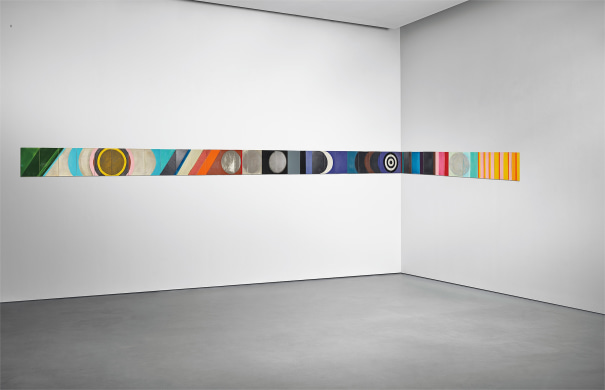
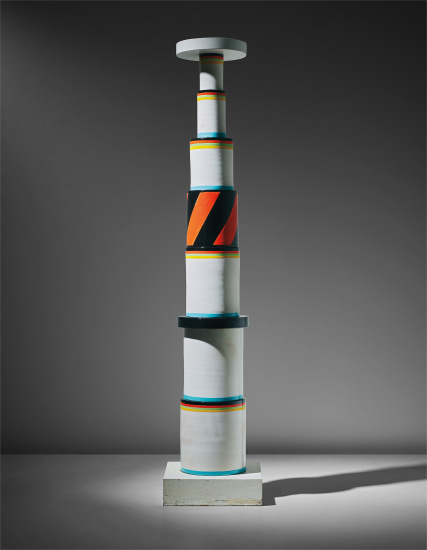

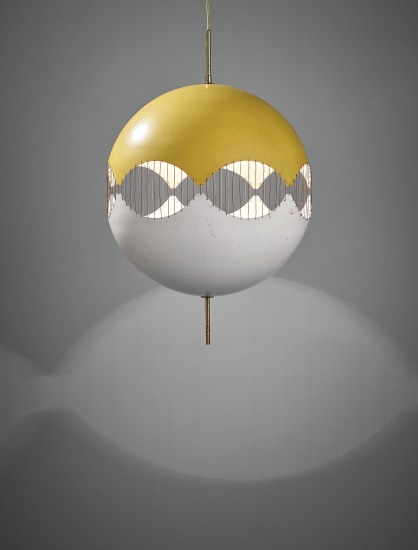

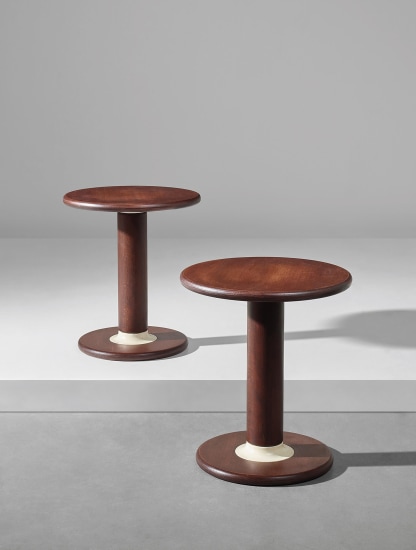
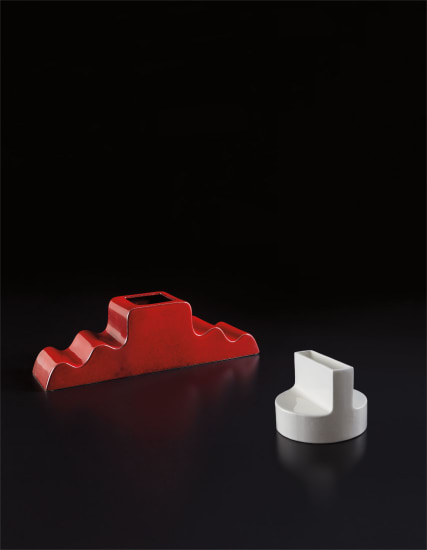
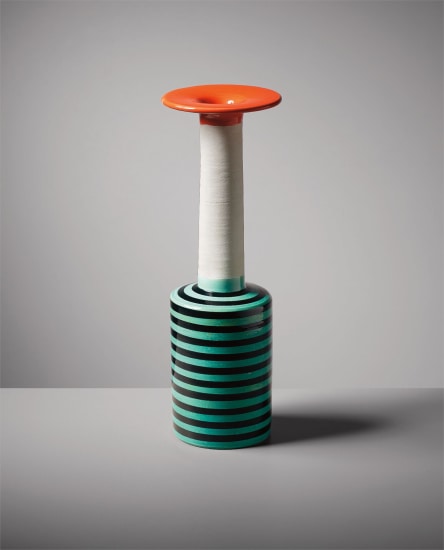

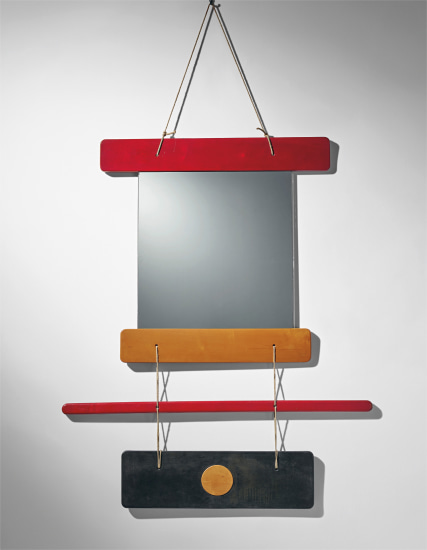

Testen Sie LotSearch und seine Premium-Features 7 Tage - ohne Kosten!
Lassen Sie sich automatisch über neue Objekte in kommenden Auktionen benachrichtigen.
Suchauftrag anlegen